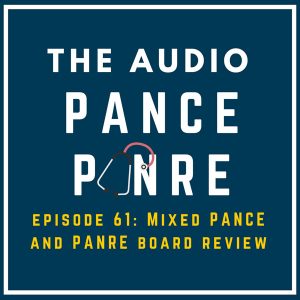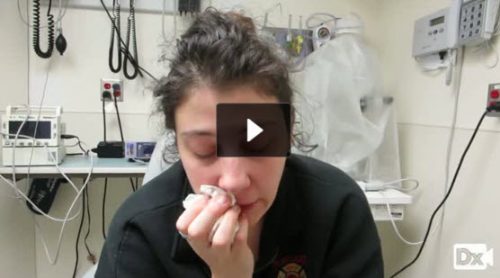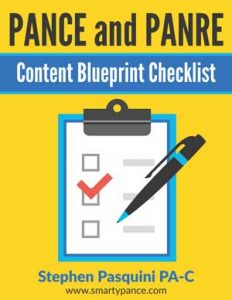Podcast: Play in new window | Download
Subscribe: Apple Podcasts | RSS
Ten Mixed NCCPA™ Content Blueprint Multiple Choice Questions
Welcome to episode 61 of the FREE Audio PANCE and PANRE Physician Assistant Board Review Podcast.
 Join me as I cover ten PANCE and PANRE Board review questions from the SMARTYPANCE course content following the NCCPA™ content blueprint (download the FREE cheat sheet).
Join me as I cover ten PANCE and PANRE Board review questions from the SMARTYPANCE course content following the NCCPA™ content blueprint (download the FREE cheat sheet).
This week we will be covering ten general board review questions based on the NCCPA PANCE and PANRE Content Blueprint.
Below you will find an interactive exam to complement the podcast.
I hope you enjoy this free audio component to the examination portion of this site. The full board review includes over 2,000 interactive board review questions and is available to all members of the PANCE and PANRE Academy and SMARTYPANCE which are now bundled together into one very low price.
- You can download and listen to past FREE episodes here, on iTunes, on Google Play Music or Stitcher Radio.
- You can listen to the latest episode, take an interactive quiz and download your results below.
Listen Carefully Then Take The Practice Exam
If you can’t see the audio player click here to listen to the full episode.
Episode 5 – General PANCE/PANRE Podcast Quiz
The following 10 questions are linked to NCCPA Content Blueprint lessons from the SMARTYPANCE and PANRE Board review website. If you are a member you will be able to log in and view this interactive video content.
1. An 18-year-old male presents with pain in his wrist after he fell off of a moving motorcycle. Physical examination reveals tenderness in the anatomic snuffbox. No fracture is noted on plain radiography of the wrist. Which of the following is the recommended treatment for this patient?
A. An ace wrap of the wrist
B. Closed reduction of the fracture site
C. Thumb spica cast application
D. Open reduction of the fracture site
2. A solitary pulmonary nodule is found on a pre-employment screening chest x-ray in a 34-year-old non-smoking male. There are no old chest x-rays to compare. Which of the following is the most appropriate next step in the evaluation?
A. CT scan of the chest
B. Needle biopsy of the lesion
C. Positron emission tomography of the chest
D. Fiberoptic bronchoscopy
Solitary pulmonary nodules are covered as part of the NCCPA PANCE Blueprint Pulmonary (12%) Content Blueprint (12%)
3. Early clues to impending delirium tremens include
A. agitation and decreased cognition.
B. visual hallucinations and diaphoresis.
C. autonomic hyperactivity and dehydration.
D. mental confusion and sensory hyperacuity.
Delirium tremens is covered as part of the NCCPA Psychiatry content blueprint (6%) under the topic of withdrawal
4. Dental caries are caused by which of the following organisms?
A. Streptococcus mutans
B. Streptococcus pyogenes
C. Staphylococcus epidermidis
D. Staphylococcus aureus
Dental caries are covered as part of the NCCPA EENT Content Blueprint (9%) under diseases of the teeth and gums
5. The most definitive treatment for primary enuresis is
A. oxybutynin chloride (Ditropan).
B. imipramine (Tofranil).
C. trimethoprim-sulfamethoxazole (Bactrim).
D. desmopressin (DDAVP)
Primary enuresis is covered under incontinence as part of the NCCPA Genitourinary Content Blueprint (6%)
6. A 47-year-old female presents to the clinic with complaints of prolonged, heavy menses that have been getting progressively worse for 3 years. She denies any pain. On physical examination, enlargement of the uterus with multiple smooth, spherical, firm masses is noted. A CBC is consistent with a mild anemia. Which of the following is the most likely diagnosis?
A. Leiomyoma
B. Adenomyosis
C. Endometriosis
D. Endometrial polyps
7. Which of the following is the laboratory test that marks recovery from Hepatitis B infection and non-infectivity?
A. Hepatitis B surface antibody(anti-HBs)
B. Hepatitis B surface antigen (HBsAg)
C. Hepatitis B core antigen (HBcAg)
D. Hepatitis A antibody (anti-HAV)
Hepatitis B serology is covered as part of acute and chronic hepatitis and is part of the NCCPA GI and Nutrition Content Blueprint (10%)
8. A 36-year-old woman admits that her husband has abused her for over ten years. You should inform the woman that she is at most risk for injury or death
A. just before a holiday.
B. just after leaving an abusive spouse.
C. when an abusive spouse arrives home after work.
D. when an abusive spouse has been drinking heavily.
Domestic violence is covered as part of the NCCPA Psychiatry Content Blueprint (6%)
9. A patient presents with an acutely painful and cold left leg. Distal pulses are absent. Leg is cyanotic. There are no signs of gangrene or other open lesions. Symptoms occurred one hour ago. Which of the following treatments is most appropriate?
A. Vena cava filter
B. Embolectomy
C. Amputation
D. Aspirin
Arterial embolism/thrombosis is covered as part of the NCCPA Cardiology Content Blueprint (16%)
10. A 53-year-old male is seen in the emergency department following a motor vehicle collision in which his knee impacted against the dashboard. The patient has a posterior knee dislocation that is promptly reduced in the emergency department. The patient currently has a palpable pulse in the dorsalis pedis and posterior tibial areas. Which of the following studies is mandatory?
A. Anterior plain film of knee
B. Sunrise view of the knee
C. Measurement of compartment pressures
D. Angiography
Fractures and dislocations of the knee are covered as part of the NCCPA Musculoskeletal Content Blueprint (10%)
Looking for all the podcast episodes?
This FREE series is limited to every other episode, you can download and enjoy the complete audio series by joining The PANCE and PANRE Exam Academy + SMARTYPANCE
I will be releasing new episodes every few weeks. The Academy is discounted, so sign up now.
Resources and Links From The Show
- My list of recommended PANCE and PANRE review books
- Download the FREE PANCE and PANRE Blueprint Checklist
- Sign up for the FREE daily PANCE and PANRE email series
- Join the Smarty PANCE NCCPA Content Blueprint Website + The PA Life Academy
- Get 20% of any Picmonic membership by using this link
- Use Code “PALIFE” and get 10% OFF THE RUTGERS PANCE AND PANRE REVIEW COURSE
This Podcast is also available on iTunes and Stitcher Radio for Android
- iTunes: The Audio PANCE AND PANRE Podcast iTunes
- Stitcher Radio: The Audio PANCE and PANRE Podcast Stitcher
Download The Content Blueprint Checklist
Follow this link to download your FREE copy of the Content Blueprint Checklist
Print it up and start crossing out the topics you understand, marking the ones you don’t and making notes of key terms you should remember. The PDF version is interactive and linked directly to the individual lessons on SMARTY PANCE.


